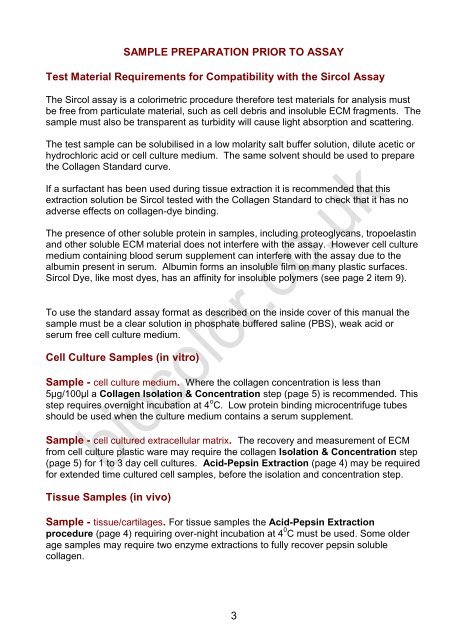Sircol Assay Manual - Biocolor Assays
Sircol Assay Manual - Biocolor Assays
Sircol Assay Manual - Biocolor Assays
Create successful ePaper yourself
Turn your PDF publications into a flip-book with our unique Google optimized e-Paper software.
SAMPLE PREPARATION PRIOR TO ASSAY<br />
Test Material Requirements for Compatibility with the <strong>Sircol</strong> <strong>Assay</strong><br />
The <strong>Sircol</strong> assay is a colorimetric procedure therefore test materials for analysis must<br />
be free from particulate material, such as cell debris and insoluble ECM fragments. The<br />
sample must also be transparent as turbidity will cause light absorption and scattering.<br />
The test sample can be solubilised in a low molarity salt buffer solution, dilute acetic or<br />
hydrochloric acid or cell culture medium. The same solvent should be used to prepare<br />
the Collagen Standard curve.<br />
If a surfactant has been used during tissue extraction it is recommended that this<br />
extraction solution be <strong>Sircol</strong> tested with the Collagen Standard to check that it has no<br />
adverse effects on collagen-dye binding.<br />
The presence of other soluble protein in samples, including proteoglycans, tropoelastin<br />
and other soluble ECM material does not interfere with the assay. However cell culture<br />
medium containing blood serum supplement can interfere with the assay due to the<br />
albumin present in serum. Albumin forms an insoluble film on many plastic surfaces.<br />
<strong>Sircol</strong> Dye, like most dyes, has an affinity for insoluble polymers (see page 2 item 9).<br />
To use the standard assay format as described on the inside cover of this manual the<br />
sample must be a clear solution in phosphate buffered saline (PBS), weak acid or<br />
serum free cell culture medium.<br />
Cell Culture Samples (in vitro)<br />
Sample - cell culture medium. Where the collagen concentration is less than<br />
5µg/100µl a Collagen Isolation & Concentration step (page 5) is recommended. This<br />
step requires overnight incubation at 4 o C. Low protein binding microcentrifuge tubes<br />
should be used when the culture medium contains a serum supplement.<br />
Sample - cell cultured extracellular matrix. The recovery and measurement of ECM<br />
from cell culture plastic ware may require the collagen Isolation & Concentration step<br />
(page 5) for 1 to 3 day cell cultures. Acid-Pepsin Extraction (page 4) may be required<br />
for extended time cultured cell samples, before the isolation and concentration step.<br />
Tissue Samples (in vivo)<br />
Sample - tissue/cartilages. For tissue samples the Acid-Pepsin Extraction<br />
procedure (page 4) requiring over-night incubation at 4 0 C must be used. Some older<br />
age samples may require two enzyme extractions to fully recover pepsin soluble<br />
collagen.<br />
3


